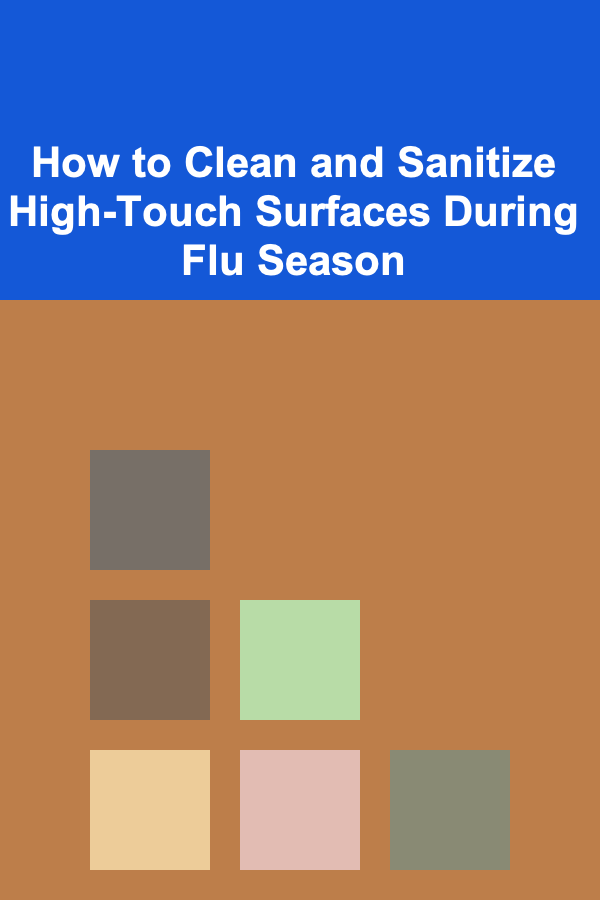
How to Clean and Sanitize High-Touch Surfaces During Flu Season
ebook include PDF & Audio bundle (Micro Guide)
$12.99$9.99
Limited Time Offer! Order within the next:

Flu season can be an overwhelming time for individuals, families, and businesses alike. As flu viruses can spread easily through physical contact and respiratory droplets, taking preventive measures to reduce exposure is critical. One of the most effective ways to limit the spread of the flu and other viral infections is by properly cleaning and sanitizing high-touch surfaces in our homes, workplaces, and public spaces. High-touch surfaces, such as doorknobs, light switches, countertops, and phones, are prime candidates for harboring germs, which is why special attention must be paid to them during flu season. In this article, we will explore the science behind the flu virus, the importance of cleaning and sanitizing high-touch surfaces, and provide a detailed guide on how to effectively clean and disinfect these surfaces.
The Science Behind the Flu Virus
Before diving into the cleaning process, it's important to understand how the flu virus spreads and why certain surfaces become hotspots for contamination. Influenza, commonly known as the flu, is caused by a virus that primarily spreads through droplets from coughing, sneezing, or talking. The virus can also survive on surfaces for a certain amount of time, depending on the material of the surface and environmental factors like temperature and humidity.
The flu virus typically survives on hard, non-porous surfaces, such as plastic, metal, or wood, for up to 24-48 hours. On porous surfaces like fabrics, it can survive for a shorter period---usually only a few hours. During flu season, when flu viruses are most prevalent, contaminated high-touch surfaces can serve as a vehicle for the virus to transfer from one person to another. Touching a contaminated surface and then touching your face (mouth, nose, or eyes) is one of the primary ways flu viruses enter the body.
Importance of Cleaning and Sanitizing High-Touch Surfaces
Cleaning and sanitizing high-touch surfaces is one of the most effective ways to reduce the spread of germs and prevent infection. High-touch surfaces, as the name implies, are those areas that people frequently come into contact with. These surfaces often accumulate germs quickly, especially in environments where many people interact, such as homes, schools, offices, public transportation, and healthcare facilities.
For example, in the home, surfaces like countertops, doorknobs, and remote controls are frequently touched by everyone in the household. In office settings, keyboards, desks, and elevator buttons are common culprits for the spread of viruses. In public spaces, high-touch areas like handrails, shopping carts, and ATM buttons can be a breeding ground for germs.
By cleaning and sanitizing these surfaces regularly, we significantly reduce the chances of the flu virus being transmitted from person to person. This is especially important during flu season when the virus is at its peak, and people are more susceptible to illness. Cleaning also helps to remove dirt, dust, and debris, which can harbor additional germs, making the space less inviting for bacteria and viruses to thrive.
Effective Cleaning vs. Sanitizing vs. Disinfecting
Before we dive into the steps for cleaning and sanitizing high-touch surfaces, it's important to understand the difference between cleaning, sanitizing, and disinfecting. These terms are often used interchangeably, but they have distinct meanings and functions in the context of germ control.
- Cleaning: Cleaning involves removing visible dirt, dust, and debris from a surface. This process typically uses water, detergent, and a scrubbing tool to physically remove contaminants from a surface. However, cleaning does not necessarily kill germs.
- Sanitizing: Sanitizing reduces the number of germs on a surface to a safe level according to public health standards. Sanitizing does not eliminate all germs, but it reduces them to a level that is not considered harmful.
- Disinfecting: Disinfecting involves killing germs, viruses, and bacteria on a surface using chemical agents. Disinfectants are usually stronger than sanitizers and are required to be in contact with a surface for a specific amount of time in order to be effective.
During flu season, it is recommended to both clean and disinfect high-touch surfaces to effectively reduce the spread of flu viruses. Cleaning removes the dirt and debris, while disinfecting ensures that any remaining germs are killed.
How to Clean and Sanitize High-Touch Surfaces
Cleaning and sanitizing high-touch surfaces involves a combination of the right cleaning products, techniques, and frequency. Let's break down the steps for effectively cleaning and sanitizing these surfaces during flu season.
Step 1: Gather the Necessary Supplies
Before you begin cleaning and sanitizing, make sure you have all the necessary supplies at hand. Some of the essential cleaning tools and products include:
- Microfiber cloths: These are effective at trapping dust, dirt, and germs without the need for harsh chemicals.
- Disinfecting wipes or sprays: Look for disinfectants that are approved by the U.S. Environmental Protection Agency (EPA) for use against the flu virus.
- All-purpose cleaner: This can be used for general cleaning and is great for removing dirt and grease.
- Soap and water: Soap and water are effective at removing visible dirt and grime, which is an essential first step before disinfecting.
- Rubber gloves: Wearing gloves can help protect your hands from harsh chemicals and germs during the cleaning process.
- Paper towels or disposable wipes: These can be used for cleaning surfaces that need to be wiped down after disinfection.
Step 2: Clean First, Disinfect Second
The first step in the cleaning process is to remove dirt, dust, and debris from the surfaces you will be disinfecting. This is because disinfectants are most effective when applied to a clean surface. If there is too much dirt or grime, the disinfectant may not work properly, as it will not make direct contact with the germs on the surface.
Here's how you can go about cleaning high-touch surfaces:
- Wipe down surfaces with soap and water: Use a microfiber cloth or a paper towel with a mixture of soap and water to clean the surface. Pay close attention to areas that accumulate grease, food particles, or dust, such as kitchen counters or office desks.
- Rinse and dry: After cleaning the surface, rinse with clean water if necessary, and allow it to air dry or wipe it dry with a clean cloth.
- Use an all-purpose cleaner for tougher grime: If there is any remaining residue or stubborn grime, use an all-purpose cleaner to scrub the surface. Be sure to follow the instructions on the label to avoid damaging the surface.
Once the surface is clean, you can move on to disinfecting.
Step 3: Disinfect the Surface
Disinfecting high-touch surfaces is essential to kill any remaining germs, including the flu virus, that may be present. Here's how you should go about disinfecting:
- Choose an EPA-approved disinfectant: Look for disinfectants that are proven effective against flu viruses. The label should mention that it kills viruses, including influenza, and should include specific instructions on how long the product should remain on the surface to effectively kill germs.
- Apply disinfectant: Spray the disinfectant onto the high-touch surface, making sure to cover it completely. If you're using disinfectant wipes, gently wipe the surface with the product.
- Allow for contact time: Most disinfectants need to stay on a surface for a specific period (usually 3 to 5 minutes) in order to effectively kill germs. Avoid wiping the surface too soon; let the disinfectant work its magic.
- Wipe dry or allow to air dry: After the required contact time, you can wipe the surface dry with a clean microfiber cloth or paper towel, or you can let it air dry.
Step 4: Pay Extra Attention to High-Touch Areas
Certain areas around the home, office, or public spaces require extra attention due to their frequency of use. These high-touch surfaces are the most likely to harbor germs, so it's essential to clean and disinfect them regularly during flu season.
Here are some common high-touch surfaces that need special attention:
- Doorknobs and handles: These are touched by almost everyone, multiple times per day.
- Light switches: Light switches are often overlooked but are frequently touched, especially in shared spaces.
- Remote controls and electronics: Phones, tablets, remote controls, and computer keyboards harbor germs due to frequent hand contact.
- Counters and tabletops: Kitchen counters, bathroom counters, and office desks are used daily for various activities.
- Handrails and elevator buttons: These surfaces in public places are often touched by many people, making them prime spots for germs.
Be sure to clean and disinfect these surfaces more frequently during flu season, especially in shared spaces.
Step 5: Practice Good Hygiene and Encourage Others to Do the Same
In addition to cleaning and sanitizing, practicing good hygiene is essential for flu prevention. Regular handwashing with soap and water for at least 20 seconds, using hand sanitizer when soap and water are unavailable, and avoiding touching the face are key practices to reduce the spread of germs. Encouraging others in your household, workplace, or public space to follow these hygiene habits can help maintain a healthy environment for everyone.
Conclusion
Cleaning and sanitizing high-touch surfaces during flu season is one of the most effective ways to prevent the spread of the flu virus and other infectious diseases. By understanding the difference between cleaning, sanitizing, and disinfecting, and by following the proper steps to clean and sanitize high-touch surfaces, you can reduce the risk of exposure to harmful germs. With regular cleaning and disinfecting, you help protect yourself, your family, and others from the flu and other illnesses, making the flu season safer for all.

How to Handle the End of a Lease Agreement and New Tenant Onboarding
Read More
How to Handle Unexpected Issues During a Home Renovation
Read More
How to Market and Sell Digital Art Portfolios: An Actionable Guide
Read More
How to Sell Digital Products Successfully for TikTok Creators
Read More
How to Turn Your Home into a Profitable Daycare Business: A Comprehensive Guide
Read More
The HR Business Partner's Playbook: Driving Organizational Success Through Talent
Read MoreOther Products

How to Handle the End of a Lease Agreement and New Tenant Onboarding
Read More
How to Handle Unexpected Issues During a Home Renovation
Read More
How to Market and Sell Digital Art Portfolios: An Actionable Guide
Read More
How to Sell Digital Products Successfully for TikTok Creators
Read More
How to Turn Your Home into a Profitable Daycare Business: A Comprehensive Guide
Read More